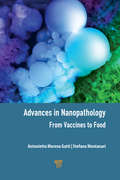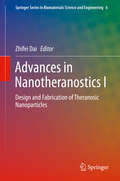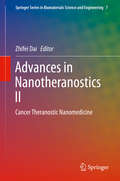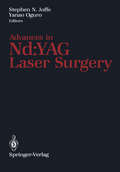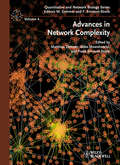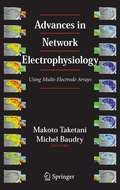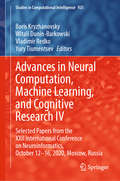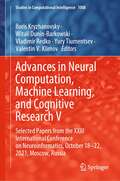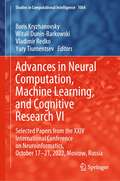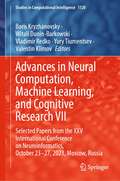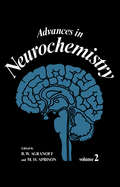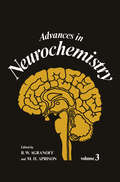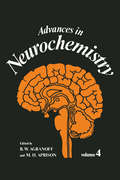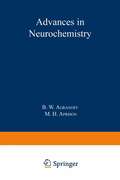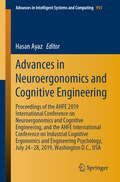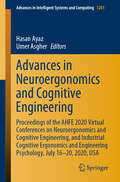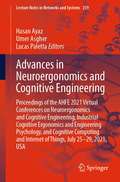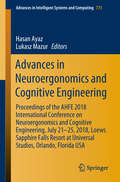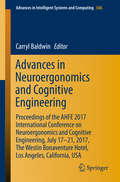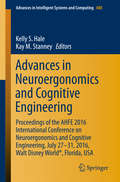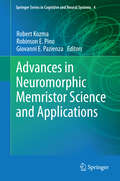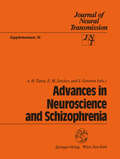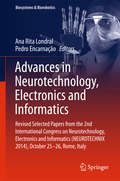- Table View
- List View
Advances in Nanopathology: From Vaccines to Food
by Antonietta Morena Gatti Stefano MontanariIf observed from an objective, epistemological standpoint, medicine is not a science, at least not in its own right. The most important, key feature missing is repeatability, which makes the doctor’s job extremely difficult. Doctors are not scientists but are called upon to use the results of scientific research every day. Therefore, they must keep themselves updated, distinguish what is worth extricating from a huge amount of literature and use the data exclusively in the patients’ interest. To be effective, medicine must start from a correct, full understanding of problems, but particulate pollution leads to too many wrong diagnoses. This book, written by the discoverers of nanopathology, is the most advanced in the field. It focuses on how natural, occasionally generated, engineered particles interfere with living organisms, food, drugs and the environment. It represents a bridge between environmental pollution and its impact on human/animal/plant health. Also unique is its new bioengineering-interdisciplinary approach to medicine and solving pathologies of unknown aetiology. It is a valuable aid for medical doctors in their diagnoses of pathologies triggered by nanoparticles internalized in the human/animal/plant body. They will find solutions to some hardly understandable symptoms which some patients report.
Advances in Nanopathology: From Vaccines to Food
by Antonietta Morena Gatti Stefano MontanariIf observed from an objective, epistemological standpoint, medicine is not a science, at least not in its own right. The most important, key feature missing is repeatability, which makes the doctor’s job extremely difficult. Doctors are not scientists but are called upon to use the results of scientific research every day. Therefore, they must keep themselves updated, distinguish what is worth extricating from a huge amount of literature and use the data exclusively in the patients’ interest. To be effective, medicine must start from a correct, full understanding of problems, but particulate pollution leads to too many wrong diagnoses. This book, written by the discoverers of nanopathology, is the most advanced in the field. It focuses on how natural, occasionally generated, engineered particles interfere with living organisms, food, drugs and the environment. It represents a bridge between environmental pollution and its impact on human/animal/plant health. Also unique is its new bioengineering-interdisciplinary approach to medicine and solving pathologies of unknown aetiology. It is a valuable aid for medical doctors in their diagnoses of pathologies triggered by nanoparticles internalized in the human/animal/plant body. They will find solutions to some hardly understandable symptoms which some patients report.
Advances in Nanotheranostics I: Design and Fabrication of Theranosic Nanoparticles (Springer Series in Biomaterials Science and Engineering #6)
by Zhifei DaiThis book highlights the recent advances in nanotheranostics from basic research to potential applications, and discusses the modular design and engineering of multiplex nanoparticles including gold nanostructures, luminescent nanoparticles, dendrimers and liposomes. Each chapter demonstrates multifunctional nanoparticles with topics covering targeting, imaging, delivery, diagnostics, and therapy as new modalities for cancer theranostics. This comprehensive book presents expert views on the latest developments in theranostic nanomedicine. It focuses on potential theranostic applications of multifunctional nanoparticles ranging from identifying noninvasively cancer cells by molecular detection, and visualizing in vivo drug delivery by means of contrast enhanced imaging, to destroying cancer cell s with minimal side effects via selective accumulation at tumor sites, and real-time monitoring therapeutic effectiveness. It also presents an interdisciplinary survey of nanotheranostics and as such is a valuable resource for researchers and students in related fields. Zhifei Dai is a Professor at the Department of Biomedical Engineering, College of Engineering, Peking University, China.
Advances in Nanotheranostics II: Cancer Theranostic Nanomedicine (Springer Series in Biomaterials Science and Engineering #7)
by Zhifei DaiThis book surveys recent advances in theranostics based on magnetic nanoparticles, ultrasound contrast agents, silica nanoparticles and polymeric micelles. It presents magnetic nanoparticles, which offer a robust tool for contrast enhanced MRI imaging, magnetic targeting, controlled drug delivery, molecular imaging guided gene therapy, magnetic hyperthermia, and controlling cell fate. Multifunctional ultrasound contrast agents have great potential in ultrasound molecular imaging, multimodal imaging, drug/gene delivery, and integrated diagnostics and therapeutics. Due to their diversity and multifunctionality, polymeric micelles and silica-based nanocomposites are highly capable of enhancing the efficacy of multimodal imaging and synergistic cancer therapy.This comprehensive book summarizes the main advances in multifunctional nanoprobes for targeted imaging and therapy of gastric cancer, and explores the clinical translational prospects and challenges. Although more research is needed to overcome the substantial obstacles that impede the development and availability of nanotheranostic products, such nontrivial nanoagents are expected to revolutionize medical treatments and help to realize the potential of personalized medicine to diagnose, treat, and follow-up patients with cancer. Zhifei Dai is a Professor at the Department of Biomedical Engineering, College of Engineering, Peking University, China.
Advances in Network Complexity (Quantitative and Network Biology (VCH))
by Matthias Dehmer Abbe Mowshowitz Frank Emmert-StreibA well-balanced overview of mathematical approaches to complex systems ranging from applications in chemistry and ecology to basic research questions on network complexity. Matthias Dehmer, Abbe Mowshowitz, and Frank Emmert-Streib, well-known pioneers in the fi eld, have edited this volume with a view to balancing classical and modern approaches to ensure broad coverage of contemporary research problems. The book is a valuable addition to the literature and a must-have for anyone dealing with network compleaity and complexity issues.
Advances in Network Complexity (Quantitative and Network Biology (VCH))
by Matthias Dehmer Abbe Mowshowitz Frank Emmert-StreibA well-balanced overview of mathematical approaches to complex systems ranging from applications in chemistry and ecology to basic research questions on network complexity. Matthias Dehmer, Abbe Mowshowitz, and Frank Emmert-Streib, well-known pioneers in the fi eld, have edited this volume with a view to balancing classical and modern approaches to ensure broad coverage of contemporary research problems. The book is a valuable addition to the literature and a must-have for anyone dealing with network compleaity and complexity issues.
Advances in Network Electrophysiology: Using Multi-Electrode Arrays
by Makoto Taketani Michel BaudryAdvances in Network Electrophysiology: Using Multi Electrode Arrays explores methods for using electrophysiological techniques for monitoring the concurrent activity of ensembles of single neurons. It reviews the recent progress in both electronics and computational tools developed to analyze the functional operations of large ensembles of neurons using multi-electrode arrays and in vitro preparations. In addition, it gives readers a sense of the applications made possible by these technological tools. This volume is the reference for researchers, industry, graduate students, and postdoctoral fellows in all areas of neuroscience, cognitive neuroscience, pharmaceutical science, and bioengineering.
Advances in Neural Computation, Machine Learning, and Cognitive Research IV: Selected Papers from the XXII International Conference on Neuroinformatics, October 12-16, 2020, Moscow, Russia (Studies in Computational Intelligence #925)
by Boris Kryzhanovsky Witali Dunin-Barkowski Vladimir Redko Yury TiumentsevThis book describes new theories and applications of artificial neural networks, with a special focus on answering questions in neuroscience, biology and biophysics and cognitive research. It covers a wide range of methods and technologies, including deep neural networks, large scale neural models, brain computer interface, signal processing methods, as well as models of perception, studies on emotion recognition, self-organization and many more. The book includes both selected and invited papers presented at the XXII International Conference on Neuroinformatics, held on October 12-16, 2020, Moscow, Russia.
Advances in Neural Computation, Machine Learning, and Cognitive Research V: Selected Papers from the XXIII International Conference on Neuroinformatics, October 18-22, 2021, Moscow, Russia (Studies in Computational Intelligence #1008)
by Boris Kryzhanovsky Witali Dunin-Barkowski Vladimir Redko Yury Tiumentsev Valentin V. KlimovThis book describes new theories and applications of artificial neural networks, with a special focus on answering questions in neuroscience, biology and biophysics and cognitive research. It covers a wide range of methods and technologies, including deep neural networks, large scale neural models, brain computer interface, signal processing methods, as well as models of perception, studies on emotion recognition, self-organization and many more. The book includes both selected and invited papers presented at the XXIII International Conference on Neuroinformatics, held on October 18-22, 2021, Moscow, Russia.
Advances in Neural Computation, Machine Learning, and Cognitive Research VI: Selected Papers from the XXIV International Conference on Neuroinformatics, October 17-21, 2022, Moscow, Russia (Studies in Computational Intelligence #1064)
by Boris Kryzhanovsky Witali Dunin-Barkowski Vladimir Redko Yury TiumentsevThis book describes new theories and applications of artificial neural networks, with a special focus on answering questions in neuroscience, biology and biophysics and cognitive research. It covers a wide range of methods and technologies, including deep neural networks, large-scale neural models, brain–computer interface, signal processing methods, as well as models of perception, studies on emotion recognition, self-organization and many more. The book includes both selected and invited papers presented at the XXIV International Conference on Neuroinformatics, held on October 17–21, 2022, in Moscow, Russia.
Advances in Neural Computation, Machine Learning, and Cognitive Research VII: Selected Papers from the XXV International Conference on Neuroinformatics, October 23-27, 2023, Moscow, Russia (Studies in Computational Intelligence #1120)
by Boris Kryzhanovsky Witali Dunin-Barkowski Vladimir Redko Yury Tiumentsev Valentin KlimovThis book describes new theories and applications of artificial neural networks, with a special focus on answering questions in neuroscience, biology and biophysics and cognitive research. It covers a wide range of methods and technologies, including deep neural networks, large-scale neural models, brain–computer interface, signal processing methods, as well as models of perception, studies on emotion recognition, self-organization and many more. The book includes both selected and invited papers presented at the XXV International Conference on Neuroinformatics, held on October 23-27, 2023, in Moscow, Russia.
Advances in Neurochemistry (Cellular Organelles)
by B. W. Agranoff M. H. AprisonIn the Preface to Volume 1, we stated: This series recognizes that investigators who have entered neurochemistry from the biochemical tradition have a rather specialized view of the brain. Too often, interdisci plinary offerings are initially attractive but turn out to recite basic biochemical considera tions. We have come to believe that there are now sufficiently large numbers of neurochemists to support a specialized venture such as the present one. We have begun with consideration of traditional areas of neurochemistry which show considerable scientific activity. We hope they will serve the neurochemist both for general reading and for specialized information. The reader will also have the opportunity to reflect on the unbridled speculation that results from the disinhibiting effects on the author who has been invited to write a chapter. We plan occasionally also to offer reviews of areas not completely in the domain of neurochemistry which we nevertheless feel to be sufficiently timely to be called to the attention of all who use chemical principles and tools in an effort to better understand the brain. The contributions to the present volume pursue these goals. We believe the series has set high standards and has continued to uphold them. In accordance with the principle stated in the last paragraph of the Preface Volume 1, we include in this volume Koshland's "Sensory Response in Bacteria" (Chapter 5).
Advances in Neurochemistry: Volume 3
by B. W. Agranoff M. H. AprisonThe original premise of the Editors in initiating this series was that there existed a readership ofneurochemists with considerable biochemical back ground who would make use of a series dedicated to both new develop ments and specialized reviews in neurochemistry. Having selected our authors, we have offered them virtually complete freedom to reflect and speculate in a field in which they have achieved prominence. The response to the first two volumes has been rewarding. The present one continues in this tradition. While we have not attempted to publish specialized volumes, the present volume contains two somewhat related chapters (Chapters 4 and 5, on the role of amino acid neurotransmitters). The first three chapters examine three diverse approaches, each of current interest, in neurochemi cal approaches to the molecular bases of neuronal and glial structure. B. W. Agranoff M. H. Aprison vii CONTENTS CHAPTER 1 2',3'-CYCUC NUCLEOTIDE 3'-PHOSPHODIESTERASE NEIL RAYMOND SIMS AND PATRICK ROBERT CARNEGIE 1. Introduction. . . . . . . . . . . . . . . . . . . . . . . . . . . . . . . . . . . . . . . . . . . . 1 2. Assay of CNPase . . . . . . . . . . . . . . . . . . . . . . . . . . . . . . . . . . . . . . . 3 2. 1. Need for Activation. . . . . . . . . . . . . . . . . . . . . . . . . . . . . . . . 3 2. 2. Comparison of Assays . . . . . . . . . . . . . . . . . . . . . . . . . . . . . . 3 3. Association of CNPase with Myelin . . . . . . . . . . . . . . . . . . . . . . . 7 3. 1. Historical. . . . . . . . . . . . . . . . . . . . . . . . . . . . . . . . . . . . . . . . . 7 3. 2. Subcellular Fractionation. . . . . . . . . . . . . . . . . . . . . . . . . . . . 8 3. 3. Development. . . . . . . . . . . . . . . . . . . . . . . . . . . . . . . . . . . . . . 8 3. 4. Mutant Mice . . . . . . . . . . . . . . . . . . . . . . . . . . . . . . . . . . . . . . 9 3. 5. Use as a Myelin Marker . . . . . . . . . . . . . . . . . . . . . . . . . . . . 10 3. 6. Myelin-Related Fractions and Peripheral Nerve Myelin. 11 4. CNPase in Nonmyelin Fractions. . . . . . . . . . . . . . . . . . . . . . . . . . 13 5. Activation and Isolation. . . . . . . . . . . . . . . . . . . . . . . . . . . . . . . . . . 13 5. 1. Introduction. . . . . . . . . . . . . . . . . . . . . . . . . . . . . . . . . . . . . . . 13 5. 2. Activation. . . . . . . . . . . . . . . . . . . . . . . . . . . . . . . . . . . . . . . . . 14 5. 3. Solubilization and Fractionation. . . . . . . . . . . . . . . . . . . . . . 15 6. Properties. . . . . . . . . . . . . . . . . . . . . . . . . . . . . . . . . . . . . . . . . . . . . . 19 6. 1. Substrate Specificity. . . . . . . . . . . . . . . . . . . . . . . . . . . . . . . .
Advances in Neurochemistry (Advances in Neurochemistry #4)
by B. W. Agranoff M. H. AprisonThis series has been directed at providing scientists possessing considerable bio chemical background with specialized reviews of neurobiological interest. Some have dealt with completed bodies of research, while others consist of extensive reports of research in progress, judged to be of current interest to the active researcher. We have selected recognized scientists and allowed them freedom to reflect and speculate in the field in which they have achieved prom inence. We note with sadness the passing of Dr. 10rdi FoIch-Pi, who served as an advisory editor when the series was initiated. He played a central role in the development of neurochemistry, as well as the creation of professional societies and journals. He will be remembered fondly by all those whose lives he touched. The editors acknowledge the cooperation of the Upjohn Company in the preparation of the color plate included in this volume. We also acknowledge the skillful editorial assistance of Dr. Kenneth C. Leskawa. We are pleased to honor the retirement of Dr. E. Martin Gal, a former advisory editor of Advances, with the inclusion of a chapter by him in this volume.
Advances in Neurochemistry
by B. W. Agranoff M. H. AprisonThe emergence of a new scientific book series requires some explanation regarding how it hopes to compensate the reader for the discomforts it undoubtedly produces both in the realms of informational input-overload and in the financial strain on personal and institutional budgets. This series recognizes that investigators who have entered neurochemistry from the biochemical tradition have a rather specialized view of the brain. Too often, interdisciplinary offerings are initially attractive but turn out to recite basic biochemical considerations. We have come to believe that there are now sufficiently large numbers of neurochemists to support a specialized venture such as the present one. We have begun with consideration of traditional areas of neurochemistry which show considerable scientific activity. We hope they will serve the neurochemist both for general reading and for specialized information. The reader will also have the opportunity to reftect on the unbridled speculation that results from the disinhibiting effects on the author who has been invited to write a chapter. We plan occasionally also to offer reviews of areas not completely in the domain of neurochemistry which we nevertheless feel to be sufficiently timely to be called to the attention of all who use chemical principles and tools in an effort to better understand the brain. B. W. Agranoff M. H. Aprison vii CONTENTS CHAPTER 1 POSSIBLE ROLES OF PROSTAGLANDINS IN THE NERVOUS SYSTEM LEONHARD S. WOLFE 1. Introduction 1 1. 1. Background 1 Names and Structures 1. 2. 4 1. 3. Biosynthesis 4 1. 4.
Advances in Neuroergonomics and Cognitive Engineering: Proceedings of the AHFE 2019 International Conference on Neuroergonomics and Cognitive Engineering, and the AHFE International Conference on Industrial Cognitive Ergonomics and Engineering Psychology, July 24-28, 2019, Washington D.C., USA (Advances in Intelligent Systems and Computing #953)
by Hasan AyazThis book offers a broad perspective on the field of cognitive engineering and neuroergonomics, covering emerging practices and future trends toward the harmonious integration of human operators and computer systems. It presents novel theoretical findings on mental workload and stress, activity theory, human reliability, error and risk, and neuroergonomic measures alike, together with a wealth of cutting-edge applications. Further, the book describes key advances in our understanding of cognitive processes, including mechanisms of perception, memory, reasoning, and motor response, with a special emphasis on their role in interactions between humans and other elements of computer-based systems. Based on the AHFE 2019 affiliated conference on Neuroergonomics and Cognitive Engineering, held on July 24-28, 2019, in Washington D.C., USA, it provides readers with a comprehensive overview of the current challenges in cognitive computing and factors influencing human performance.
Advances in Neuroergonomics and Cognitive Engineering: Proceedings of the AHFE 2020 Virtual Conferences on Neuroergonomics and Cognitive Engineering, and Industrial Cognitive Ergonomics and Engineering Psychology, July 16-20, 2020, USA (Advances in Intelligent Systems and Computing #1201)
by Hasan Ayaz Umer AsgherThis book offers broad overview of the field of cognitive engineering and neuroergonomics, covering emerging practices and future trends toward the harmonious integration of human operators and computer systems. It presents novel theoretical findings on mental workload and stress, activity theory, human reliability, error and risk, and a wealth of cutting-edge applications, such as strategies to make assistive technologies more user-oriented. Further, the book describes key advances in our understanding of cognitive processes, including mechanisms of perception, memory, reasoning, and motor response, with a particular focus on their role in interactions between humans and other elements of computer-based systems. Gathering the proceedings of the AHFE 2020 Virtual Conferences on Neuroergonomics and Cognitive Engineering, and Industrial Cognitive Ergonomics and Engineering Psychology, held on 16–20 July 2020, this book provides extensive and timely information for human–computer interaction researchers, human factors engineers and interaction designers, as well as decision-makers.
Advances in Neuroergonomics and Cognitive Engineering: Proceedings of the AHFE 2021 Virtual Conferences on Neuroergonomics and Cognitive Engineering, Industrial Cognitive Ergonomics and Engineering Psychology, and Cognitive Computing and Internet of Things, July 25-29, 2021, USA (Lecture Notes in Networks and Systems #259)
by Hasan Ayaz Umer Asgher Lucas PalettaThis book offers a broad overview of the field of cognitive engineering and neuroergonomics, covering emerging practices and future trends toward the harmonious integration of human operators and computational systems. It gathers both theoretical and practice-oriented studies on mental workload and stress, activity theory, human reliability, error and risk. It covers applications in various field, and corresponding strategies to make assistive technologies more user-oriented. Further, the book describes key advances in our understanding of cognitive processes, including mechanisms of perception, memory, reasoning, and motor response, with a particular focus on their role in interactions between humans and other elements of computer-based systems. Gathering the proceedings of the AHFE 2021 Conferences on Neuroergonomics and Cognitive Engineering, Industrial Cognitive Ergonomics and Engineering Psychology, and Cognitive Computing and Internet of Things, held virtually on July 25-29, 2021, from USA, this book offers extensive information and a thought-provoking guide for researchers and practitioners in cognitive engineering, neuroergonomics and their applications.
Advances in Neuroergonomics and Cognitive Engineering: Proceedings of the AHFE 2018 International Conference on Neuroergonomics and Cognitive Engineering, July 21–25, 2018, Loews Sapphire Falls Resort at Universal Studios, Orlando, Florida USA (Advances in Intelligent Systems and Computing #775)
by Hasan Ayaz Lukasz MazurThis book offers a broad perspective on the field of cognitive engineering and neuroergonomics, covering emerging practices and future trends toward the harmonious integration of human operators and computer systems. It presents novel theoretical findings on mental workload and stress, activity theory, human reliability, error and risk, and neuroergonomic measures alike, together with a wealth of cutting-edge applications. Further, the book describes key advances in our understanding of cognitive processes, including mechanisms of perception, memory, reasoning, and motor response, with a special emphasis on their role in interactions between humans and other elements of computer-based systems. Based on the AHFE 2018 affiliated conference on Neuroergonomics and Cognitive Engineering, held on July 21–25, 2018, in Orlando, Florida, USA, it provides readers with a comprehensive overview of the current challenges in cognitive computing and factors influencing human performance.
Advances in Neuroergonomics and Cognitive Engineering: Proceedings of the AHFE 2017 International Conference on Neuroergonomics and Cognitive Engineering, July 17–21, 2017, The Westin Bonaventure Hotel, Los Angeles, California, USA (Advances in Intelligent Systems and Computing #586)
by Carryl BaldwinThis book offers a broad perspective on the field of cognitive engineering and neuroergonomics, covering emerging practices and future trends toward the harmonious integration of human operators with computational systems. It reports on novel theoretical findings on mental workload and stress, activity theory, human reliability, error and risk, and neuroergonomic measures alike, together with a wealth of cutting-edge applications. Further, the book describes key advances in our understanding of cognitive processes, including mechanisms of perception, memory, reasoning, and motor response, with a special emphasis on their role in interactions between humans and other elements of computer-based systems. Based on the AHFE’s main track on Neuroergonomics and Cognitive Engineering, held on July 17–21, 2017 in Los Angeles, California, USA, it provides readers with a comprehensive overview of the current challenges in cognitive computing and factors influencing human performance.
Advances in Neuroergonomics and Cognitive Engineering: Proceedings of the AHFE 2016 International Conference on Neuroergonomics and Cognitive Engineering, July 27-31, 2016, Walt Disney World®, Florida, USA (Advances in Intelligent Systems and Computing #488)
by Kelly S. Hale Kay M. StanneyThis book offers a broad perspective on the field of cognitive engineering and neuroergonomics. It covers emerging practices and future trends towards the harmonious integration of human operators with computational systems. The book reports on novel theoretical findings on mental workload and stress, activity theory, human reliability, error and risk, and neuroergonomic measures alike, together with a wealth of cutting-edge applications. It describes key advances in the understanding of cognitive processes, including mechanisms of perception, memory, reasoning, and motor response, giving a special emphasis to their role in the interactions between humans and the other elements of a computer-based system. Based on the AHFE’s main track on Neuroergonomics and Cognitive Engineering, held on July 27-31, 2016 in Walt Disney World®, Florida, USA, the book provides readers with a comprehensive view of the current challenges in cognitive computing and factors influencing human performance.
Advances in Neuromorphic Memristor Science and Applications (Springer Series in Cognitive and Neural Systems #4)
by Robert Kozma, Robinson E. Pino and Giovanni E. PazienzaPhysical implementation of the memristor at industrial scale sparked the interest from various disciplines, ranging from physics, nanotechnology, electrical engineering, neuroscience, to intelligent robotics. As any promising new technology, it has raised hopes and questions; it is an extremely challenging task to live up to the high expectations and to devise revolutionary and feasible future applications for memristive devices. The possibility of gathering prominent scientists in the heart of the Silicon Valley given by the 2011 International Joint Conference on Neural Networks held in San Jose, CA, has offered us the unique opportunity of organizing a series of special events on the present status and future perspectives in neuromorphic memristor science. This book presents a selection of the remarkable contributions given by the leaders of the field and it may serve as inspiration and future reference to all researchers that want to explore the extraordinary possibilities given by this revolutionary concept.
Advances in Neuroscience and Schizophrenia (Journal of Neural Transmission. Supplementa #36)
by S. Gershon E. M. Stricker A. H. TumaSchizophrenia has been the subject of intense research interest in recent years, as investigators have explored the biological bases for the disorder and for various approaches to its diagnosis and treatment. This volume focuses on three aspects of such recent research connecting basic neuroscience to schizophrenia. In one, Professors Budinger, Gur, and Pettegrew provide critical reviews of brain imaging studies as they relate to cognitive behaviour functions in schizophrenia. In the second, Professors Goldmann-Rakic, Lewis, and Tassin discuss monoamine systems and their varied role in prefontal cortical circuitry and function. In the third, Professors Deutsch, Gerfen, and Grace discuss the structure, organization, and function of the basal ganglia, as they relate to schizophrenia and the mechanisms of neuroleptic action. These papers were presented at an interdisciplinary workshop on the subject at the University of Pittsburgh, in May 1991, and the discussion between the authors and other panelists in basic and clinical sciences are included in this volume as well. The presentation of these diverse approaches in an integrated fashion provides the reader with a unique perspective and a wealth of new questions for future collaborative research.
Advances in Neurotechnology, Electronics and Informatics: Revised Selected Papers from the 2nd International Congress on Neurotechnology, Electronics and Informatics (NEUROTECHNIX 2014), October 25-26, Rome, Italy (Biosystems & Biorobotics #12)
by Ana Rita Londral Pedro EncarnaçãoThis book is a timely report on current neurotechnology research. It presents a snapshot of the state of the art in the field, discusses current challenges and identifies new directions. The book includes a selection of extended and revised contributions presented at the 2nd International Congress on Neurotechnology, Electronics and Informatics (NEUROTECHNIX 2014), held October 25-26 in Rome, Italy. The chapters are varied: some report on novel theoretical methods for studying neuronal connectivity or neural system behaviour; others report on advanced technologies developed for similar purposes; while further contributions concern new engineering methods and technological tools supporting medical diagnosis and neurorehabilitation. All in all, this book provides graduate students, researchers and practitioners dealing with different aspects of neurotechnologies with a unified view of the field, thus fostering new ideas and research collaborations among groups from different disciplines.
